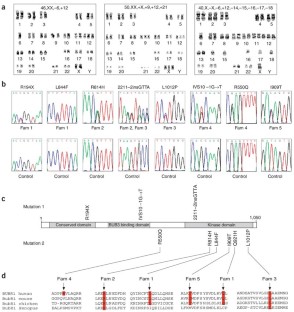Constitutional aneuploidy and cancer predisposition caused by biallelic mutations in BUB1B (original) (raw)
- Brief Communication
- Published: 10 October 2004
- Kim Coleman1,
- Sarah Reid1,
- Alberto Plaja2,
- Helen Firth3,
- David FitzPatrick4,
- Alexa Kidd5,
- Károly Méhes6,
- Richard Nash3,
- Nathanial Robin7,
- Nora Shannon8,
- John Tolmie9,
- John Swansbury10,
- Alexandre Irrthum1,
- Jenny Douglas1 &
- …
- Nazneen Rahman1
Nature Genetics volume 36, pages 1159–1161 (2004)Cite this article
- 8815 Accesses
- 522 Citations
- 7 Altmetric
- Metrics details
Abstract
Mosaic variegated aneuploidy is a rare recessive condition characterized by growth retardation, microcephaly, childhood cancer and constitutional mosaicism for chromosomal gains and losses. In five families with mosaic variegated aneuploidy, including two with embryonal rhabdomyosarcoma, we identified truncating and missense mutations of BUB1B, which encodes BUBR1, a key protein in the mitotic spindle checkpoint. These data are the first to relate germline mutations in a spindle checkpoint gene with a human disorder and strongly support a causal link between aneuploidy and cancer development.
This is a preview of subscription content, access via your institution
Access options
Subscribe to this journal
Receive 12 print issues and online access
$209.00 per year
only $17.42 per issue
Buy this article
- Purchase on SpringerLink
- Instant access to full article PDF
Prices may be subject to local taxes which are calculated during checkout
Additional access options:
Figure 1: Typical karyotypic abnormalities and BUB1B mutations identified in individuals with MVA.

Similar content being viewed by others
Accession codes
Accessions
GenBank/EMBL/DDBJ
References
- Bharadwaj, R. & Yu, H. Oncogene 32, 2016–2027 (2004).
Article Google Scholar - Draviam, V.M. et al. Curr. Opin. Genet. Dev. 14, 120–125 (2004).
Article CAS Google Scholar - Lengauer, C. et al. Nature 396, 643–649 (1998).
Article CAS Google Scholar - Tolmie, J.L. et al. Hum. Genet. 80, 197–200 (1988).
Article CAS Google Scholar - Limwongse, C. et al. Am. J. Med. Genet. 82, 20–24 (1999).
Article CAS Google Scholar - Plaja, A. et al. Am. J. Med. Genet. 98, 216–223 (2001).
Article CAS Google Scholar - Kajii, T. et al. Am. J. Med. Genet. 104, 57–64 (2001).
Article CAS Google Scholar - Jacquemont, S. et al. Am. J. Med. Genet. 109, 17–21 (2002).
Article Google Scholar - Tang, Z. et al. Dev. Cell 1, 227–237 (2001).
Article CAS Google Scholar - Mao, Y. et al. Cell 114, 87–98 (2003).
Article CAS Google Scholar - Shin, H.-J. et al. Cancer Cell 4, 483–497 (2003).
Article CAS Google Scholar - Dai, W. et al. Cancer Res. 64, 440–445 (2004).
Article CAS Google Scholar - Baker, D.J. et al. Nat. Genet. 36, 744–749 (2004).
Article CAS Google Scholar - Cahill, D.P. et al. Nature 392, 300–303 (1998).
Article CAS Google Scholar - Shichiri, M. et al. Cancer Res. 62, 13–17 (2002).
CAS PubMed Google Scholar
Acknowledgements
We thank all the families that gave informed consent to take part in this research; the many clinicians that were involved in their diagnosis and management, including D. Bain, H. Cox, A. Green, A. McEwen, T. Vendrell, P. Ellis and R. Murray; M. Stratton and A. Futreal for advice on the manuscript; and K. Tatton-Brown and T. Min for help in preparation of the figure. A.I. is supported by Tenovus the Cancer Charity. This research was supported and approved by the Institute of Cancer Research (UK).
Author information
Authors and Affiliations
- Section of Cancer Genetics, Institute of Cancer Research, Sutton, Surrey, UK
Sandra Hanks, Kim Coleman, Sarah Reid, Alexandre Irrthum, Jenny Douglas & Nazneen Rahman - Unitat de Genetica, Hospital Materno-Infantil Vall d'Hebron, Barcelona, Spain
Alberto Plaja - Medical Genetics Department, Addenbrooke's Hospital, Cambridge, UK
Helen Firth & Richard Nash - MRC Human Genetics Unit, Edinburgh, Scotland
David FitzPatrick - Central Regional Genetic Services, Wellington Hospital, Wellington, New Zealand
Alexa Kidd - Department of Medical Genetics and Child Development, University of Pécs, Hungary
Károly Méhes - Department for Human Genetics, Case Western Reserve University, Cleveland, Ohio, USA
Nathanial Robin - West Midland Regional Genetics Service, Birmingham Women's Hospital, Birmingham, UK
Nora Shannon - Institute of Medical Genetics, Glasgow, Scotland
John Tolmie - Section of Haemato-oncology, Institute of Cancer Research, Sutton, Surrey, UK
John Swansbury
Authors
- Sandra Hanks
- Kim Coleman
- Sarah Reid
- Alberto Plaja
- Helen Firth
- David FitzPatrick
- Alexa Kidd
- Károly Méhes
- Richard Nash
- Nathanial Robin
- Nora Shannon
- John Tolmie
- John Swansbury
- Alexandre Irrthum
- Jenny Douglas
- Nazneen Rahman
Corresponding author
Correspondence toNazneen Rahman.
Ethics declarations
Competing interests
The authors declare no competing financial interests.
Rights and permissions
About this article
Cite this article
Hanks, S., Coleman, K., Reid, S. et al. Constitutional aneuploidy and cancer predisposition caused by biallelic mutations in BUB1B.Nat Genet 36, 1159–1161 (2004). https://doi.org/10.1038/ng1449
- Received: 14 July 2004
- Accepted: 10 September 2004
- Published: 10 October 2004
- Issue Date: 01 November 2004
- DOI: https://doi.org/10.1038/ng1449